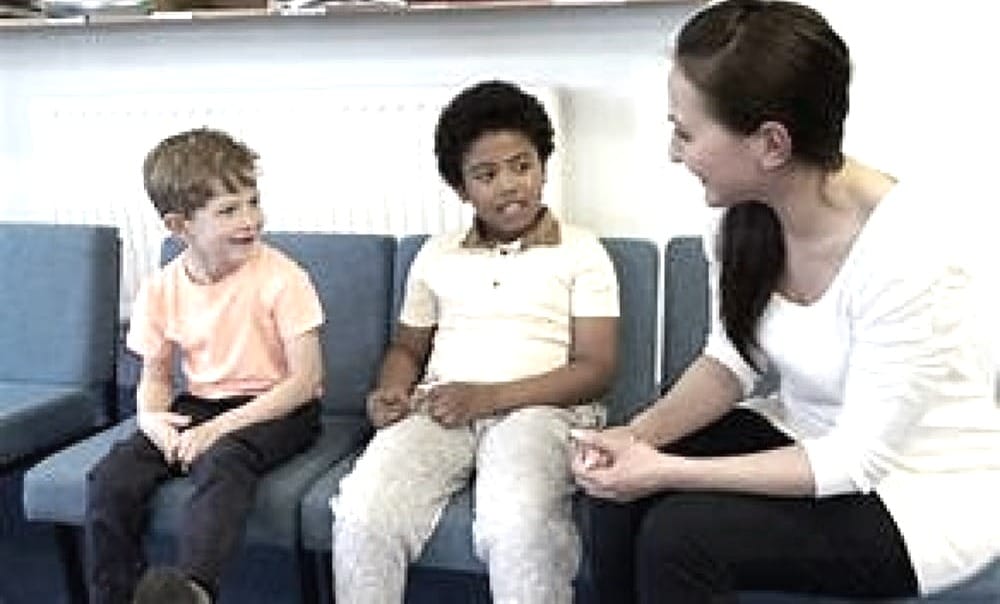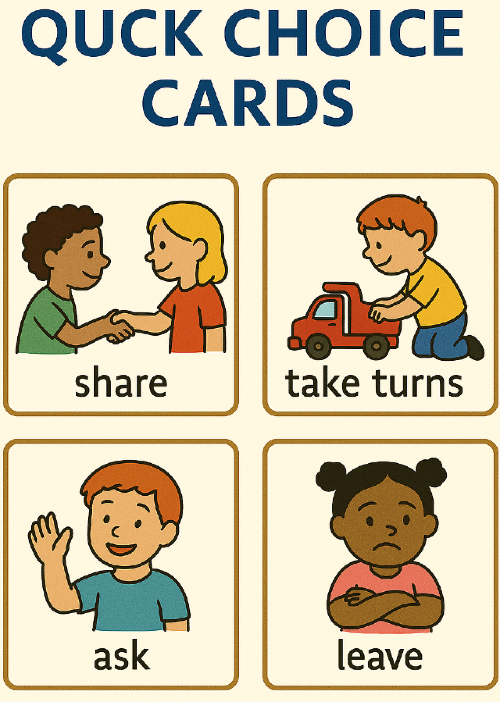Stay On the Sidelines, Coach!

Gentle ways to guide children through peer conflicts, without taking over
Parents, many of us have experienced this scenario: Your child and a friend are mid-argument about who goes first, voices rising, eyes brimming. Every cell in your body wants to jump in and fix it. But what children need most in these moments is not a referee but a coach. When we coach instead of control, children practice perspective-taking, problem-solving, and emotional regulation. Those lifelong skills are tied to better relationships and school success.¹
Below is a friendly, step-by-step guide you can use right away, plus two realistic scenarios that commonly occur in your living room or on the playground.
The “S.I.D.E.” Coaching Flow
S – Scan before stepping in.
Take three slow breaths and quickly read the room. Is anyone unsafe? If not, resist the rescue. Give it 10–20 seconds to see if the children try anything constructive.
I – Identify the feelings and the problem.
Kneel to their level: “I’m hearing loud voices. It sounds like you both want the same toy. Did I get that right?” Naming feelings helps children calm down enough to think.
D – Drop prompts, not solutions.
Offer small, open-ended nudges:
- “What are two fair ways to decide?”
- “How could both of you get some of what you want?”
Prompts keep ownership with the children, which boosts motivation and follow-through.²
E – Encourage and exit.
When they agree on a plan, state it back: “Great, you’re setting a 3-minute timer and then switching.” Then physically step out. Hovering can signal, “You can’t do this without me.”
Scenario 1: The Board Game Blow-Up (Ages 6–8)
The scene: Two children, Ava (6) and Malik (8), are halfway through a Snakes and Ladders board game. Malik rolls the dice and moves his piece, but Ava yells, “That’s cheating, you skipped a space!” Malik insists, “No, I didn’t!” Both are upset, and the game is at risk of ending in tears.
What not to do: “That’s enough, I’ll decide who’s right. Malik goes back one space.”
This solves an immediate fight, but takes away their chance to practice fairness and conflict resolution.
Coach does this instead:
- Scan: No danger; just high feelings. Take a breath before jumping in.
- Identify: “I hear both of you are upset. Ava, you feel like Malik skipped a space. Malik, you say you didn’t. Is that the problem?”
- Drop prompts:
- “What’s a fair way to figure this out?”
- “How could we check the rules together?”
- “If you can’t agree, what’s a fair backup plan so the game can keep going?”
- If stuck, offer gentle options: re-check the rules card, replay the turn, or roll again with both watching closely.
Likely outcome: They agree to re-check the rules card and replay Malik’s turn.
Why this works: At this age, fairness is important to children. By naming feelings, encouraging perspective-taking, and prompting them to use the game’s rules as a neutral guide, you help them practice solving conflicts without adult-imposed solutions.
Scenario 2: The Playground Chase (Ages 6-8)
The scene: Two children, Diego (7) and Lila (6), are playing “Tag”. Diego tags Lila, but she insists, “You didn’t touch me!” Diego argues, “Yes, I did, on your sleeve!” Their voices rise, and the other children pause the game.
What not to do: “Diego tagged you, Lila. No arguing, keep playing.”
This keeps the game moving but prevents them from learning how to handle fairness disputes.
Coach like this instead:
- Scan: No one is unsafe; just disagreement.
- Identify: “It sounds like Diego feels he tagged you, and Lila, you don’t think he did. Is that right?”
- Drop prompts:
- “What are two fair ways to solve this so the game can keep going?”
- “How could you decide together if this tag counts?”
- “Do you want to make a quick rule for next time so it’s clearer?”
- If they’re stuck, suggest: replay the round, have both agree to a “do-over,” or create a new rule (e.g., tags must be on the back or shoulder).
Likely outcome: They agree on a “do-over” and add a rule that tags must be on the back so everyone can see them clearly.
Why this works: Children in this age group value games and rules deeply. Coaching them to co-create and refine their rules helps them practice negotiation, fairness, and group problem-solving; all skills they’ll use well beyond the playground.
Scenario 3: The Sandbox Shuffle (Ages 3–5)
The scene: Two preschoolers, one red shovel. Jordan grabs it, but Mia yells, “I want it!” Both cling tightly.
What not to do: “Jordan had it first; Mia, you wait.” This ends the fight quickly but doesn’t build skills.
Coach like this instead:
- Scan: No danger; just strong feelings.
- Identify: “You both want the red shovel. That’s hard when there’s only one.”
- Drop prompts: “What’s a way you could both have a turn?” “What can we do while we wait?”
If silence, offer two simple choices:
A) Timer—Jordan digs for 2 minutes, then Mia.
B) Trade—Jordan uses the shovel, Mia gets the bucket, then they switch.
Likely outcome: They pick the timer and agree to trade later.
Why this works: Even very young children begin to see fairness and learn that problems can have more than one solution.
Gentle Phrases That Keep You in Coach Mode
- “I believe you two can figure this out.”
- “What’s a fair plan that will satisfy both of you?”
- “Say that again, but kinder.”
- “Do you want time to think?”
Why Coaching Beats Controlling
When adults jump straight to solving, children learn compliance. When adults coach, children learn competence: naming feelings, negotiating, planning, and evaluating outcomes. Large reviews of social-emotional programmes confirm lasting gains in behavior and academics when children practice these skills regularly.¹ And from a motivation standpoint, strategies that support autonomy, competence, and related aptitudes (like limited choices, clear goals, and connection) increase children’s willingness to engage and persist, especially during conflicts.²
Activity: Quick Choice Cards
Take 4 small plain cards and sketch a picture on each one (parents can sketch if kids can’t yet):
- Timer Turns
- Trade (swap toys)
- Together (use it side by side)
- Pause (take a short break)
When conflict pops up, invite your child to pick one card. The pictures make it simple, even if reading is hard. You remain the calm, curious, and confident coach; they can do it.

Footnotes
- Durlak, J. A., Weissberg, R. P., Dymnicki, A. B., Taylor, R. D., & Schellinger, K. B. (2011). The impact of enhancing students’ social and emotional learning: A meta-analysis of school-based universal interventions. Child Development, 82(1), 405–432.
- Deci, E. L., & Ryan, R. M. (2000). The “what” and “why” of goal pursuits: Human needs and the self-determination of behavior. Psychological Inquiry, 11(4), 227–268.